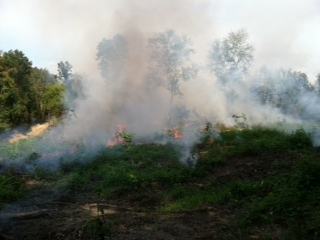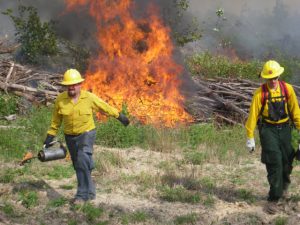Prescribed Burn Underway to Create Oak-Savannah
September 28, 2012Rehabilitated Barred Owl Released Back Into the Wild at Long Creek Conservation Area
October 17, 2012 The North Carolina Forest Service (NCFS) and Catawba Lands Conservancy conducted a safe and successful prescribed burn on Sept 28, 2012, at the Buffalo Creek Preserve in Mount Pleasant, Cabarrus County.
The North Carolina Forest Service (NCFS) and Catawba Lands Conservancy conducted a safe and successful prescribed burn on Sept 28, 2012, at the Buffalo Creek Preserve in Mount Pleasant, Cabarrus County.
Several rangers that are certified burners were at the preserve to conduct the burn and ensured the safety of surrounding properties and natural areas. The rangers operated from a burning plan that is designed to accomplish the objectives of the burn and manage the fire conditions and smoke. CLC staff also attended and assisted with the burn. Several months ago, CLC sent letters to residents living near the burn site to explain the burn process and address questions.
Buffalo Creek Preserve is a 392-acre permanently protected area owned by CLC. The burn took place on a 70-acre portion of the preserve. The fire lasted for a few hours with monitoring and patrol occurring for several hours to hinder fire reoccurrence. Measures are also in place for smoke control and monitoring.
Prior to taking ownership of the property in 2011, CLC staff observed native warm-season grasses in an area where trees had been harvested in 2008. Working with biologists from the North Carolina Wildlife Resources Commission (WRC), US Fish and Wildlife Service (USFWS), and the Natural Resource Conservation Service (NRCS), CLC further identified this area as one that would provide an opportunity to establish an important wildlife habitat.
The prescribed burn will help develop a piedmont oak-savannah, an open natural area that is conducive for the growth of native warm-season grasses. In the spring of 2013, an array of native grasses will grow within the burned area – providing an ideal habitat for grasshopper sparrows and populations of wild turkey quail and other birds. The prescribed burn will also help remove fuels from the soil and reduce the potential for wildfires.
Fire is a natural part of both the forest and grassland ecology. According to John Isenhour, a technical assistance biologist with the WRC, this prescribed burn is important because it will suppress woody regeneration and restore populations of native plants and grasses important to North Carolina’s wildlife.
“Savannah habitats are vital to many species of wildlife and are among the most rapidly declining ecosystems in the state,” said Isenhour.
In December of 2011, the 392-acre Buffalo Creek Preserve was donated to CLC. In addition to what will soon be a 70-acre oak-savannah, the property protects at least 120-acres of active farmland and hayfields and will have a trail as part of the Carolina Thread Trail.
